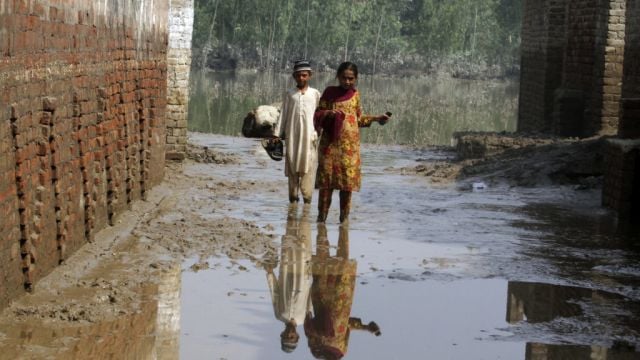Pakistani health officials have reported an outbreak of waterborne diseases in areas hit by record-breaking flooding as authorities step up efforts to provide clean drinking water to hundreds of thousands of people who lost their homes in the disaster.
The UN children’s agency said more than three million children were in need of humanitarian assistance and were at heightened risk of diseases, drowning and malnutrition due to the most severe flooding in Pakistan’s recent history.
Pakistani authorities and aid agencies were also working to secure medical facilities for thousands of pregnant women, who were among 33 million people affected by floods.
Diarrhoea, skin diseases and eye infections are spreading at relief camps set up by the government across the country.

More than 90,000 diarrhoea cases were reported in one of the worst-hit provinces, Sindh, in the past 24 hours, according to health officials.
The latest development comes a day after Pakistan and the World Health Organisation raised concern over the spread of waterborne diseases among flood victims.
Pakistan blames climate change for unusually early and heavy monsoon rains, which since June have caused flash floods that have killed 1,191 people and affected 33 million people.
About a million homes have also been damaged or destroyed
Floodwaters continued to recede in the most of the country, but many districts in southern Sindh province remained underwater.

Nearly half a million displaced people are living in relief camps. In Sindh province, thousands of medical camps have been set up in flood-stricken areas to treat victims, said Dr Azra Fazal Pechuho, the provincial health minister. Mobile medical units have also been deployed.
The World Health Organisation says it is increasing surveillance for acute diarrhoea, cholera and other communicable diseases and providing medical supplies to health facilities.
Doctors say they were initially seeing mostly patients traumatised by the flooding, but are now treating thousands of people suffering from diarrhoea, skin infections and other waterborne ailments.
Many pregnant women living in flood-affected areas were also exposed to risks.
According to Minister for Poverty Alleviation Shazia Marri, the government was aware of the problems faced by pregnant women and children and was acting swiftly to help.
According to the UN Population Fund, 6.4 million flood victims in Pakistan need humanitarian assistance. It said about 650,000 pregnant women in flood-affected areas need maternal health services, including 73,000 expected to deliver in the next month.

Children were at special risk, Unicef said in a statement.
“When disasters hit, children are always among the most vulnerable,” Abdullah Fadil, Unicef representative in Pakistan, said. The floods had damaged 17,566 schools, the agency added.
Meanwhile, rescuers backed by the military continued operations to take marooned people to safer places. Rescuers are mostly using boats, but helicopters are also flying to evacuate stranded people from areas where bridges and roads were destroyed, making it difficult to evacuate people and deliver food to them.
Days ago, Pakistan and the United Nations issued an appeal for £138 million in emergency funding. On Thursday, Prime Minister Shahbaz Sharif thanked the United Arab Emirates for delivering the first tranche of relief goods worth £43 million, and thanked the US for announcing £25 million in aid.
Several countries, including Turkey, China, Qatar and Saudi Arabia, have sent planeloads of aid to flood victims in Pakistan.
According to initial government estimates, the devastation caused £8.6 billion in damages.







